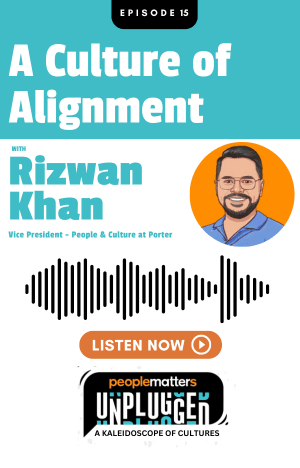Agility across IT systems & processes are gaining momentum: Reliance Industries’ HR Tech leader

Vaibhav Goel, the Vice President HR – Digital Transformation at Reliance Industries, India, has over 15 years of experience in Strategic HR and digital transformations. An HR Leader with strategic acumen and entrepreneurial passion, he is deeply involved in HR digital innovation and agile transformation at Reliance Group. He has spent the last five years working closely with senior leadership and stakeholders to drive futuristic ways of working. People Matters asked him for his thoughts on how the COVID-19 pandemic has changed the way HR tech is used and where he sees the HR tech landscape going globally as the world changes.
Here are the excerpts.
Has the pandemic brought about a drastic change in terms of how organizations leverage technologies? How do you see this overnight digital transformation of businesses?
Organizations being part of overall societal institutions and their purpose being to serve their customers better and better, it is but natural that when customers' as well as employees’ life, preferences, and behaviors undergo a radical shift, correspondingly organizations ought to be re-thinking and re-imagining business fundamentals. And that should take place at scale and in a globally synchronized fashion in response to a global pandemic.
The real shift in fact has not been in technologies per se, which were already available for quite sometime. The shift has happened in their agile application by companies, first in business-critical operations and now holistically across every aspect of the business value chain.
We all have been fortunate to have some of these agile and cloud technologies handily available, which has helped most organizations to respond to this global pandemic in a much better manner than expected. Just a decade back, something like the SARS-CoV-2 virus would have been ten times more devastating to human life and global economies when even smartphones were not a very common device.
How has the HR tech landscape changed over the last few months? Do you see a major change in terms of how HR leverage technologies?
HR Tech is profoundly impacted, probably the most among all other business functions. HR Tech enables (or disables!) every employee, and goes much beyond in terms of creating lasting employee impressions. While EX-employee experience—has been on the agenda for most of the progressive organizations, two specific trends have picked up momentum globally, as a result of COVID-19.
The first is agility across IT systems and processes, and the second is personalization. In fact, combining agility with personalization is a winning formula for designing context-specific and tailor-made employee experiences around productivity, well-being, and learning to upskill or reskill. A chatbot/assistant based approach makes adoption even more intuitive at scale. These technologies are no longer ‘’nice to talk about’’ or small pilots but are seeing speedy implementations on a global scale.
In fact, most organizations are now open to plug-n-play solutions beyond the traditional HR tech players, as they are not ready to wait for multi-year release plans from big Cloud HCM players.
As business leaders begin to grapple with how to architect the future of HR in a time of uncertainty, they must focus on technology changes that can deliver immediate results. What are some of the most critical business challenges that HR and work technology can help organizations solve today?
The redefined partnership between HR and technology is effectively addressing the most critical business challenges like productivity and innovation in truly re-imagined ways and at a faster pace.
Talking first of productivity, while it’s a function of the business model ranging from consumer services to manufacturing, still, common design elements like the transparent alignment of teams, real-time business outcome tracking, and weekly-monthly course corrections are becoming new levers of productivity and performance in this VUCA world. While HR is redrafting the policy aspects and helping leadership mindset shifts, technology is the enabler giving us platforms to drive OKRs (Objectives and Key Results), continuous feedback, and collaboration, making these designs possible in the very first place.
Secondly, with pandemic disruption, crowdsourcing innovation capital in every business has become an organizational survival competence that is needed at different levels in the value chain. An effective strategy hence is to crowdsource innovation directly from the front lines in an open and transparent manner. Again, while HR has to augment some of the Reward and Recognition policies to fuel an innovation ethos across the organizational layers, we have some very powerful platforms, which can help drive the entire idea-to-prototype life cycle in a truly agile manner in days and weeks!
What role can leaders play to ensure a better alignment of HR technology investment and business goals?
Leaders have the most important role and are a make or break factor for most businesses and organizations, but the ‘leadership ask’ for this global reset is not easy. What is required, is a fusion of principles of ‘Servant Leadership’ with ‘Digital Mindset’. To put it succinctly, servant leadership is rightly summed up by Robert Greenleaf in his 1970 article as, ‘Servant leadership flips the typical leadership script by putting people ahead of (personal) power. A servant leader prioritizes the team’s growth and well-being, letting their own needs and ambition take a backseat’.
The most important characteristics to be a servant leader are to be really self-aware (and work on self), authentic listening (be with your team member wholly), empathy (knowing what makes each team member tick!), and building a community of support.
But the ask is even greater, as leaders have to have a digital mindset in everything they try to do. All leaders need to have a crash course on new-age technologies but also be humble to learn from the new generation of talent. This means shifting from ''know-it-all'' mindset to a ''learn-it-all'' mind-set!
The pandemic has pushed upskilling and reskilling into the limelight. How can talent leaders ensure seamless learning for their virtual workforce? How are you ensuring workplace learning for your employees?
An open access to learning resources and a culture of continuous learning are critical for upskilling and reskilling. For talent leaders, this is probably the biggest challenge for the foreseeable future. They really need to articulate the business priorities linked to the skills framework, which itself will remain dynamic, and further need to craft learning paths that will lead to actual skill acquisitions which are deployable and productive. This requires re-designing learning frameworks, learning platform landscapes, and learning policies to drive a continuous learning culture.
More progressive talent leaders are able to drive ‘’precision learning’’ and ‘’just in time’’ learning solutions. The key is to have a proper skills framework and curated content ecosystem. We are deploying all these strategies at scale, uniquely tailored to business and talent market requirements.
Most management leaders do appreciate that the talent and skill market is extremely dynamic, and learning agility is going to be a competitive advantage for our organization.
How do you see the future of HR tech globally as we come out of this crisis? Which technology among AI, ML, automation tools, RPA, and Augmented Reality are you most excited about and why?
I am particularly excited about the ‘’Intelligent Automation’’ possibilities that arise from the various innovative use cases for AI. At one end, it has tremendous scope to improve efficiencies as most of the transactions and even simpler data-driven decision making with set patterns can be automated, while at the other end AI is truly helping in leveraging large scale data to find insights, which can be weaved into workflows resulting in hyper-personalization of experiences. Design creativity in this space is just beginning to explode.
RPA has been around for sometime and is relevant only in certain use cases.
AR still is 2-3 years away from large scale use cases and will require an improved infrastructure of bandwidth and devices at scale. Having said that, AR can still make an impact in specific uses cases of employee engagement, learning, and organizational communication. The future of HR Tech is definitely exciting and this future is all about the ‘’art of possible’’.














